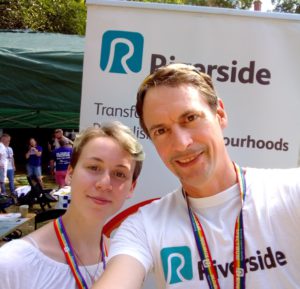By Simon Allcock, Interim Head of Projects
This weekend I attended my third Sparkle Festival, a national event to celebrate gender identity. And this year felt particularly special to me.
I have talked with my children after the Sparkle weekend each year – about the experiences I’ve had, and the people I’ve met. My 18 year old daughter Polly has been fascinated – and after we talked last year she said she’d like to come.
So this year we drove up together in the car on Friday night and stayed over with my cousin, driving into central Manchester on the Saturday morning to Sackville Gardens, Canal street – home of the famous statue of Alan Turing in the heart of Manchester’s gay village.
My introduction to trans awareness over the last three years has been massively interesting, often awkward and frequently challenging. I still know very little about the excruciatingly uncomfortable daily issues people face, about the background of ridicule and open abuse that people encounter just going about their daily lives – so common that it almost fades in the background. Did you know that 40% of trans people have attempted suicide? 40%.
When I talk about gender identity I’m often halting, searching for the right words, out of my comfort zone, trying to remember the correct term. What I’ve come to realise over time is that none of that matters. What I think really does matter is that I’m open minded, have respect, want to understand and willing to help.
I love the Sparkle Weekend – set up the Riverside stall and before you know it, you are engaged in one conversation after another with the nicest people you could hope to meet. Talking about housing, homelessness, links to the LGBT community, Riverside’s work on trans awareness and our individual success stories, and where we could do more. My memory of the afternoon is a wonderful cascade of images, sounds and ideas.
The most powerful to me was a conversation between Polly and Riverside’s Danielle Oliver. It was about pronouns and people who do not identify with the ‘either/or’ menu which I grew up with – you are either a male or you are a female.
Polly and I had studied together a chart about gender identity and we were looking at these two different but similar ways of looking at the situation:
This one is the GenderBread Person model – you mark on the chart where you feel you fit. As a cis man, (comfortable with the gender I was assigned at birth) I would mark my man-ness high and my woman-ness low. So far so good.
And this is the Gender Unicorn. I was initially confused how this second diagram had an option for a positive association with a gender other than just male or female. What would this gender be? What options were there – I was getting bogged down in the detail.
Enter Polly, totally at ease. She has trans and non-binary friends, and she just says: “Well whatever feels right to them”.
And as Danielle mentions the work Riverside has been doing to increase the use of non-binary language, especially pronouns, Polly says without a hint of hesitation: “Yes we use they and them”. She means that in her friendship group, rather than referring to he or she, it can make more sense to use non gender-specific terminology like they and them.
It’s as simple as that.
And so until our younger generation take over and apply their inclusivity to the world, we can help by allowing gender identity to be more complex than just male and female.
